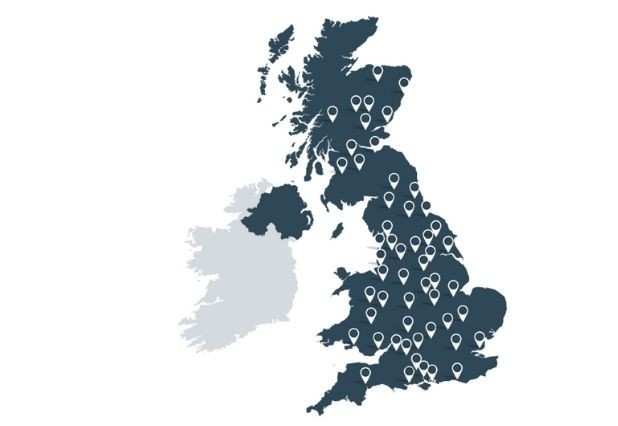
Our Nationwide Coverage
Hearing Aid UK is a nationwide network of around 200+ hearing aid audiologists
We have an audiologist in your area
Wherever you are located, we usually have two or three hearing aid audiologists within that area to cater for all your hearing loss needs. To find out where your nearest audiologist is, call 0800 567 7621 or complete the contact form further down the page.
Whether you're in a major city, a coastal town, or a rural village, we can bring expert hearing care to your doorstep, wherever you are in the UK. Our local audiologists are familiar with your area and ready to deliver personalised, professional support right where you need it.
We offer free home visits
All our hearing aid audiologists provide home visits at no extra cost, so wherever you are, we can come to you. Be aware that some other companies may not offer this service, and many of them positively discourage it.
We believe high-quality hearing care should be accessible and convenient, especially for those who may struggle to get to a clinic.
With our free home visit service, you’ll receive the same professional care in the comfort and privacy of your own home. Our audiologists bring all the latest equipment with them, ensuring your consultation and fitting are just as thorough as in a clinic setting.
From your first test to ongoing aftercare, everything can be handled at home, with no pressure, no rush, and no additional fees.


Benefits of Home Visits and Impartial Advice with Hearing Aid UK
The majority of appointments with hearing aid dispensers are actually fine-tuning appointments.
The best place to fine-tune a hearing aid is in an acoustic environment in which the aid(s) will be worn, most commonly in your home.
If you’ve worn digital hearing aids before and had adjustments made in a shop or clinic, you may appreciate that the full implication of these fine-tuning sessions is sometimes not realised until you get home (and then it’s too late).
Many hearing aids today incorporate "wireless" technology. This can involve connecting accessories to your television or telephone, etc. This cannot be done remotely unless you want to do it yourself.

Many of our clients either do not wish to travel or cannot travel for necessary ongoing appointments. These appointments are included in the cost of the hearing aid(s).
Whilst you may be in a position to travel right now, will things still be the same in five, six, or so years?
Hearing aids should last at least 5 years and very often much longer. Aftercare is included for the life of the hearing aids.
Our digital hearing aid audiologists are actually working in your vicinity all the time. Should you require urgent attention, we can respond very quickly.
Most people’s homes are quiet enough to perform a hearing test. This is done using headphones, which eliminate most external noises. “Insert headphones” are used if noise levels are too high.
High street shops and busy hospitals/clinics need soundproof booths – that’s why they usually use them.
The equipment these days is very light and portable. Many functions are carried out on a laptop computer.
Meet the Hearing Aid UK Team
Visiting a local audiologist offers numerous benefits for individuals experiencing hearing issues
Our audiologists are highly trained and experienced in diagnosing and treating various hearing problems.
They have in-depth knowledge of auditory health and can provide personalised solutions tailored to your specific needs.
Our local audiologists are easily accessible, allowing for regular check-ups and follow-up appointments to monitor the progress of treatment plans.
They also offer convenience with free home visits, minimising travel time and expenses. Seeing a local audiologist also creates a strong sense of community and enables patients to build a trusting and ongoing relationship with their healthcare provider.
Hearing aid retailer articles you might like...
 Specsavers vs Amplifon: What are the differences?
Specsavers vs Amplifon: What are the differences?  Switching to a New Hearing Aid Provider
Switching to a New Hearing Aid Provider  Boots Hearingcare vs Hidden Hearing: What's the difference between the two?
Boots Hearingcare vs Hidden Hearing: What's the difference between the two? Watch our hearing healthcare services video below
Our specialist service includes:
Do not spend hundreds of pounds without getting a second opinion from us.
Please call us on 0800 567 7621
 Not only are the prices great, but the service is fantastic! Many thanks to your team.
Not only are the prices great, but the service is fantastic! Many thanks to your team.What's included in our hearing aid prices?
Other pages you might find useful
Common FAQs when researching hearing healthcare and hearing aids
In general, any audiologist will always recommend to you the hearing aid model that best suits your needs. Here is a useful checklist to make sure that is the case.
- Audiologist's level of knowledge: The audiologist you have seen will hopefully have a wide knowledge of all available hearing aids; however, some will only be familiar with a small number of brands and, therefore, may not really be in a position to know which model is the best for you. It is OK to challenge their recommendation and ask them to justify why this particular brand is the one for you.
- Do research: Read about the hearing aid that was recommended. Does it seem like it will suit your lifestyle? Does it have more or fewer features than you need?
- Be aware of sales targets: Many high street retailers have specific tie-ins to a particular manufacturer/brand. The hearing aid they have suggested may still be the correct one for you, but do your research so that you know why they might have recommended it.
If you have significant hearing loss in both ears, you should be wearing two hearing aids. Here are the audiological reasons why:
Localisation: The brain decodes information from both ears and compares and contrasts them. By analysing the minuscule time delays as well as the difference in the loudness of each sound reaching the ears, the person is able to accurately locate a sound source.
Simply put, if you have better hearing on one side than the other, you can't accurately tell what direction sounds are coming from.
Less amplification is required: A phenomenon known as “binaural summation” means that the hearing aids can be set at a lower and more natural volume setting than if you wore only one hearing aid.
Head shadow effect: High frequencies, the part of your hearing that gives clarity and meaning to speech sounds, cannot bend around your head. Only low frequencies can. Therefore, if someone is talking on your unaided side, you are likely to hear that they are speaking, but be unable to tell what they have said.
Noise reduction: The brain has its own built-in noise reduction, which is only really effective when it is receiving information from both ears. If only one ear is aided, even with the best hearing aid in the world, it will be difficult for you to hear in background noise as your brain is trying to retain all of the sounds (including background noise) rather than filtering them out.
Sound quality: We are designed to hear in stereo. Only hearing from one side sounds a lot less natural to us.
Fancy some further reading on this topic? You can read about why two hearing aids are better than one in our article, hearing aids for Both Ears, here
For most people, the main benefit of a rechargeable hearing aid is simple convenience. We are used to plugging in our phones and other devices overnight for them to charge up. Here are some other pros and cons:
For anybody with poor dexterity or issues with their fingers, having a rechargeable aid makes a huge difference, as normal hearing aid batteries are quite small and some people find them fiddly to change.
One downside is that if you forget to charge your hearing aid, then it is a problem that can't be instantly fixed. For most, a 30-minute charge will get you at least two or three hours of hearing, but if you are the type of person who is likely to forget to plug them in regularly, then you're probably better off with standard batteries.
Rechargeable aids are also a little bit bigger and are only available in Behind-the-Ear models.
Finally, just like with a mobile phone, the amount of charge you get on day one is not going to be the same as you get a few years down the line. Be sure to ask what the policy is with the manufacturer's warranty when it comes to replacing the battery.
For most people, the answer is yes. But it's never that simple.
The majority of hearing problems affect the high frequencies a lot more than the low ones. Therefore, open fitting hearing aids sound a lot more natural and ones that block your ears up can make your own voice sound like you are talking with your head in a bucket. Therefore, in-ear aids tend to be less natural.
However, the true answer is we can't tell until we have had a look in your ears to assess the size of your ear canal, and until we have tested your hearing to see which frequencies are being affected.
People with wider ear canals tend to have more flexibility, also there are open fitting modular CIC hearing aids now that do not block your ears.
There is also the age-old rule to consider, that a hearing aid will not help you if it's sat in the drawer gathering dust. If the only hearing aid you would be happy wearing is one that people can't see, then that's what you should get.
Most people can adapt to any type of hearing aid, as long as they know what to expect. Have an honest conversation with your audiologist as to what your needs are.
Generally speaking, six or more. Unless it's none at all. The number of channels a hearing aid has is often a simplistic way an audiologist will use to explain why one hearing aid is better than another, but channels are complex, and it is really not that straightforward. Here are some reasons why:
Hearing aids amplify sounds of different frequencies by different amounts. Most people have lost more high frequencies than low, and therefore need more amplification in the high frequencies. The range of sounds you hear is split into frequency bands or channels, and the hearing aids are set to provide the right amount of hearing at each frequency level.
Less than six channels, and this cannot be done with much accuracy, so six is the magic number. However, a six-channel aid is typically very basic with few other features and is suitable only for hearing a single speaker in a quiet room. The number of channels is not what you should be looking at; it's more the rest of the technology that comes with them.
As a final note, different manufacturers have different approaches. One method is not necessarily better than any other. For example, some manufacturers have as many as 64 channels in their top aids. Most tend to have between 17 and 20. One manufacturer has no channels at all.
Manufacturer's warranties typically last between 2-5 years, depending on the brand and model, and cover defects in materials and workmanship. This includes repairs for component failures, electronic malfunctions, and manufacturing defects, but excludes damage from misuse, accidents, or normal wear. Most manufacturers also include loss and damage insurance for the first year.
We handle all warranty claims on your behalf, liaising with manufacturers and ensuring you get replacement devices quickly when needed. This comprehensive warranty coverage, combined with our lifetime aftercare, gives you complete peace of mind.
Our hearing tests are completely free, whether at our clinics or in your home. Unlike other providers who charge £30-£100 for home visits, we believe hearing healthcare should be accessible without financial barriers. Our comprehensive assessments include examination by a registered audiologist, audiogram results, and personalised recommendations.
All testing, future adjustments, and ongoing support are included at no extra cost. While NHS tests are also free, typical 6-week waiting periods often lead people to seek immediate private testing. We provide prompt, professional assessments that fit your schedule and budget.
Yes, we offer completely free home visits throughout the UK, and this service is included in our prices with no additional charges. Home visits are particularly valuable for people with mobility issues, busy schedules, or those who simply prefer the comfort and convenience of their own environment.
Our audiologists can conduct full hearing tests, fit hearing aids, and provide ongoing support in your home. This service sets us apart from many providers who either don't offer home visits or charge extra for them.
We can offer prices up to 40% lower than high street retailers because of our business model. As a network of 200+ independent audiologists, we don't have the massive overheads of large retail chains - no expensive high street premises, no sales targets pushing audiologists to sell the most expensive options, and no costly marketing campaigns.
However, we maintain the same buying power as the big chains because we purchase on behalf of our entire nationwide network. This means you get access to the same premium hearing aids with professional service, but at genuinely competitive prices.
We offer a comprehensive 60-day money-back guarantee, which gives you twice the industry standard time to properly assess whether your hearing aids are right for you. This extended period recognises that adjusting to hearing aids takes time, and your brain needs several weeks to adapt to the amplified sounds.
Unlike many providers who offer just 30 days, we believe 60 days gives you the confidence to test your hearing aids in all the situations that matter to you - from quiet conversations at home to busy restaurants and outdoor activities.
Ask the Experts
6 Morton Lane
Walkwood
Redditch
Worcestershire
B97 5QA
Latest Launch
When we refer to a product as 'Latest Launch', we mean it is the latest to be released on the market.
New
When we refer to a product as 'New', we mean that the product is the newest hearing aid model on the market.
When we refer to a product as 'Superseded', we mean that there is a newer range available which replaces and improves on this product.
Older Model
When we refer to a product as an 'Older Model', we mean that it is has been superseded by at least two more recent hearing aid ranges.




